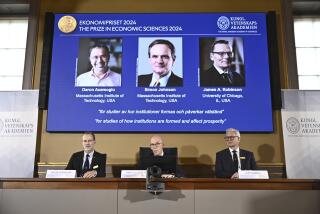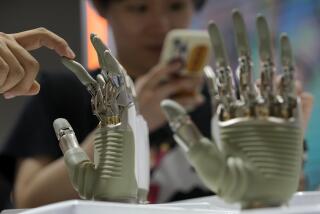‘Human Capital’ Gets the Short End : U.S. Business Is Dragged Down by Fat Executive Wallets
- Share via
A high-powered study commission made several recommendations the other day for getting the U.S. economy back in world-championship form. But it emphasized that a big ingredient must be an end to the negative attitude among American businessmen toward the people who work for them.
The 16-member group, commissioned by the Massachusetts Institute of Technology, included Robert Solow, the Nobel Prize-winning economist, and Paul Gray, MIT president.
The need for greater investment of money and respect in “human capital” is gaining currency--even inside corporate boardrooms. But the prevalent attitude is still the one described by Michael Dertouzos, chairman of the study commission. Too many managers, he said, “still look at the work force as a cost to be minimized, instead of as a resource” to be nurtured and developed for greater profit and efficiency. The accuracy of his statement is borne out by the events of recent years.
Despite the emergence of huge trade and budget deficits in the 1980s, the U.S. economy is in its seventh year of expansion. A rising tide is supposed to lift all boats, but these have been years of a widening gap between the haves and have-nots. Top corporate executives have done well, to say the least.
According to a Business Week survey of the two highest-paid executives at each of 354 companies, 11 received total compensation in 1988 in the $10.9-million to $40 million range. The average was more than $2 million. That’s several times the average just a few years back, and well above the remuneration of corporate chieftains in other countries whose competitive performance has been far better.
The explosion in executive compensation wouldn’t be so reprehensible if it hadn’t come at a time when most other Americans were struggling to prevent erosion of their living standards.
In 1960, the average chief executive officer received 41 times the average pay of factory workers, 38 times the average for schoolteachers and 19 times the average for engineers. In 1988, those ratios had widened to 93 to 1, 72 to 1 and 44 to 1.
According to congressional data, the poorest one-fifth of Americans have become still poorer in the 1980s. And even those with jobs have done well to keep their heads above water as U.S. business waged an all-out campaign to regain competitiveness by cutting labor costs.
Work forces were slashed. Plants were closed and in many cases moved overseas. The use of “temporary” employees “rented” from an agency came into vogue. Typically, such workers are paid much less than full-time employees and are not eligible for company health-insurance plans and pensions. And they can be let go when business turns down.
In human terms, the structural readjustment has been painful. According to government data, nearly 10 million Americans lost their jobs to layoffs and plant closings from 1983 to 1988. By early last year, 70% of the displaced workers had new jobs. But, even without adjustment for inflation, almost half of the re-employed were earning less than in their old jobs.
On the whole, real wages are barely higher than 15 years ago. And if the U.S. trade balance remains badly out of whack, it isn’t because Americans are paid more than foreign workers.
The Institute of German Business reports that the average West German worker, though still second to his Swiss counterpart, now receives 34.22 marks per hour in pay and benefits--or about $18.11 in American greenbacks.
Japanese workers come in sixth at $14.94 an hour--still ahead of American workers, who at $13 an hour are placed 12th.
Meanwhile, both the Japanese and Germans continue to beat the socks off American business in world trade competition.
This underscores the point by management expert Peter Drucker--that low blue-collar wages do not provide a competitive edge in today’s world because they are an increasingly small share of total costs. Other approaches to higher productivity are more important, including greater efforts to nurture an able, motivated work force.
Truly well-run companies already recognize this fact. The MIT study group observed, however, that Japanese and West German firms still invest far more than most U.S. companies in on-the-job worker training and retraining, and that neglect of human resources may be American business’ biggest failing.
There are notable exceptions, but authorities say too many U.S. executives remain reluctant to recognize that investments in new technology and equipment must be accompanied by equally great attention to the human factor in the workplace.
As Business Week has said of the far too prevalent mind-set:
“Every extra dollar spent on workers is viewed as that much more of a burden, whereas it could be, if wisely spent, a means to empower workers to do better.”
Folks pocketing $2 million a year ought to be smart enough to know that.
More to Read
Inside the business of entertainment
The Wide Shot brings you news, analysis and insights on everything from streaming wars to production — and what it all means for the future.
You may occasionally receive promotional content from the Los Angeles Times.










